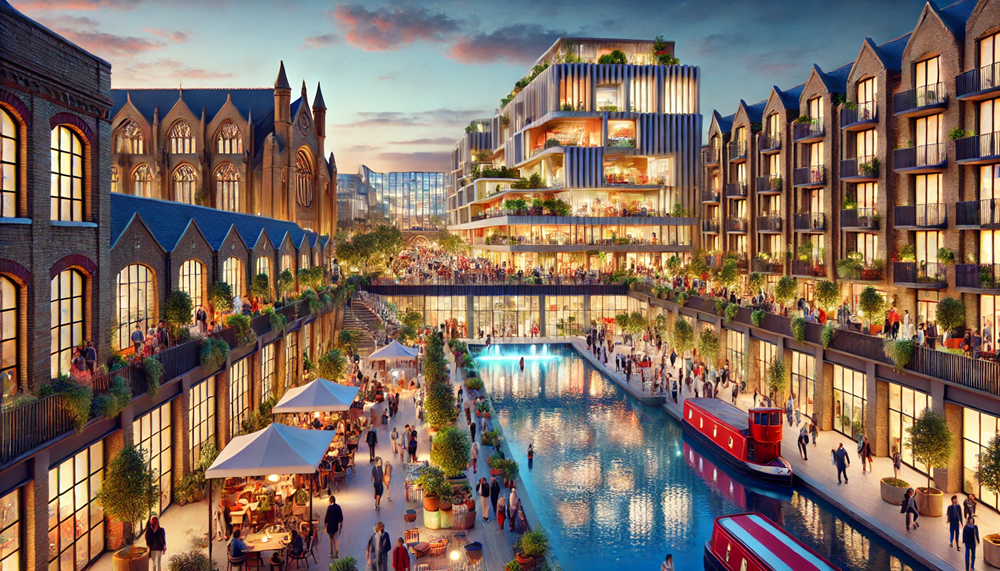Introduction to Mixed Use Housing
Mixed-use housing is a key component of modern urban planning, combining residential, commercial, and cultural spaces within a single development. This approach fosters vibrant, walkable communities, reducing reliance on cars and enhancing the overall quality of life. In London, mixed-use developments are increasingly shaping the cityscape, transforming former industrial areas into thriving neighbourhoods that integrate housing, businesses, and public amenities.

The Benefits of Mixed-Use Housing
1. Promoting Sustainable Living
Mixed-use developments reduce the need for extensive commuting by offering amenities, workplaces, and leisure options within walking distance. With a combination of housing, retail spaces, and public services, residents can meet their daily needs while minimising car usage, ultimately reducing congestion and air pollution.
Public transport is also a key feature in these developments, with many integrating bus routes, cycling lanes, and train stations to further enhance connectivity. For example, the inclusion of Crossrail stations in Stratford and Canary Wharf has made these areas even more accessible.
2. Encouraging Community Interaction
By bringing together different types of people, including families, young professionals, and older adults, mixed-use housing fosters social interaction and community cohesion. Public plazas, shared gardens, and cultural spaces enhance social engagement, while the presence of businesses and recreational facilities encourages a lively atmosphere.
3. Economic and Urban Regeneration
These developments stimulate economic activity by attracting businesses, creating job opportunities, and boosting the local economy. Small businesses thrive in areas with built-in foot traffic, and commercial spaces help sustain local employment. Moreover, repurposing underutilised spaces revitalises urban areas, turning former industrial zones into thriving communities.
Key Mixed-Use Developments in London
1. King’s Cross Development
One of the most prominent mixed-use projects in London, King’s Cross, has transformed a 67-acre former industrial site into a dynamic urban hub. The development includes over 50 buildings, featuring apartments, townhouses, penthouses, offices, retail spaces, and cultural venues.
The presence of Central Saint Martins College of Arts and Design has enriched the area’s cultural fabric, making it a creative hotspot. Green spaces such as Granary Square and Regent’s Canal further contribute to a high-quality urban environment, promoting sustainability and community engagement.
2. Nine Elms and Battersea Power Station
The Nine Elms regeneration project is another striking example, featuring a mix of residential, commercial, and leisure spaces along the South Bank of the Thames. With over 17,000 new homes and nearly 2 million square feet of commercial space, this development is redefining the area.
A key landmark in Nine Elms is Battersea Power Station, which has been repurposed into a vibrant mixed-use district, combining luxury residences, office spaces, shops, and entertainment venues. The Northern Line extension has further improved connectivity, making it easier for residents to access Central London.
3. Stratford and the Olympic Legacy
The regeneration of Stratford following the 2012 Olympic Games is a testament to how mixed-use housing can transform an area. The Olympic Village, now known as East Village, has become a thriving neighbourhood with a diverse range of housing options, shops, and public spaces. The development promotes sustainable living with energy-efficient homes, green spaces, and strong public transport links.
Challenges and Considerations
While mixed-use housing presents many benefits, there are challenges to consider:
- Balancing Uses: Ensuring an appropriate mix of residential, commercial, and cultural spaces to meet community needs.
- Infrastructure Demand: Increased population density requires robust public transport, healthcare, and educational facilities.
- Affordable Housing: Ensuring that developments include a variety of housing types to accommodate people of different income levels.
London’s planning policies, such as the London Plan, play a crucial role in addressing these challenges by guiding sustainable development and ensuring balanced urban growth.
Conclusion
Mixed-use housing is reshaping London’s urban landscape, offering a sustainable solution to housing shortages, economic revitalisation, and urban regeneration. With developments like King’s Cross, Nine Elms, and Stratford leading the way, mixed-use projects continue to provide vibrant, interconnected communities that support a higher quality of life. As London grows, integrating residential, commercial, and cultural spaces will remain essential for creating sustainable and livable neighbourhoods.